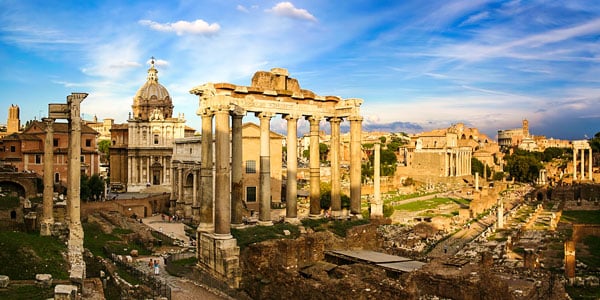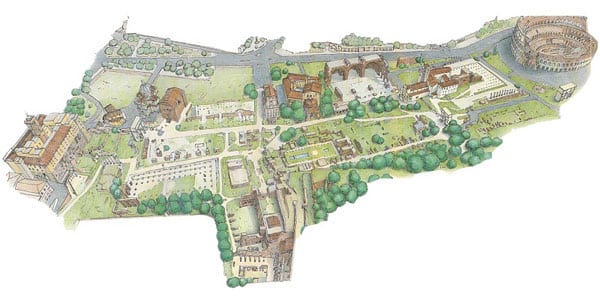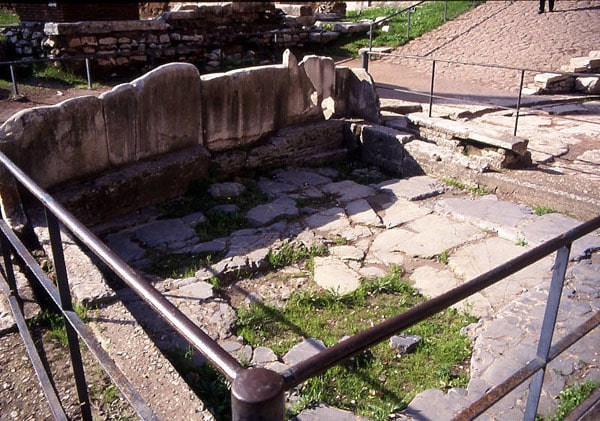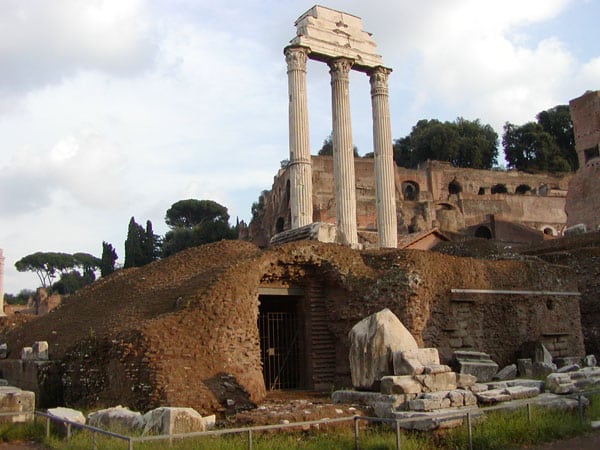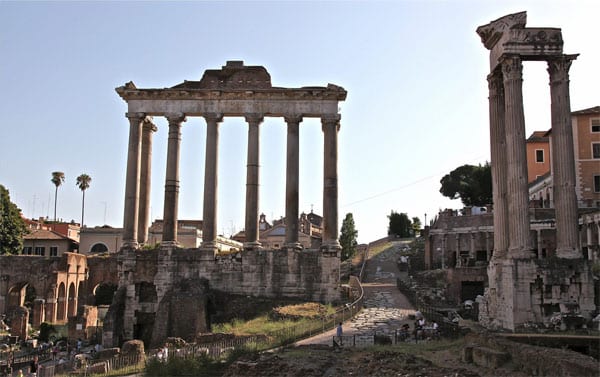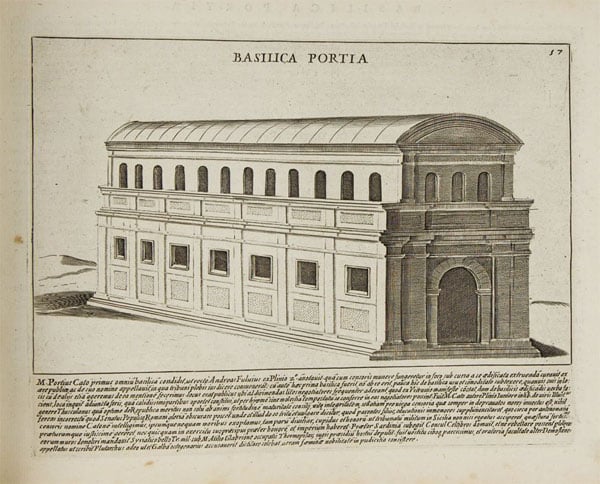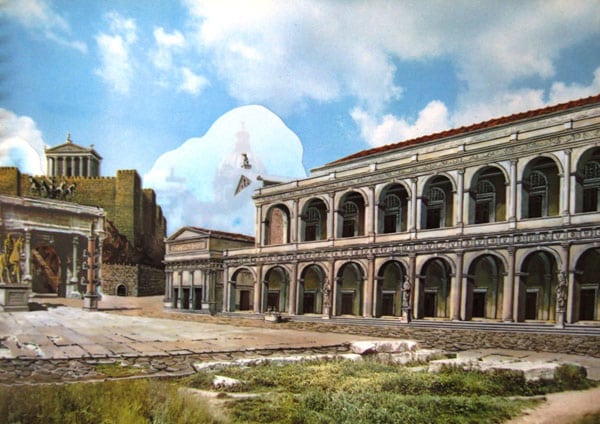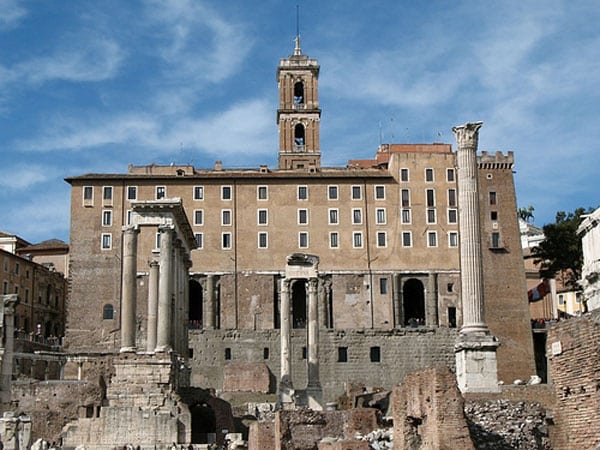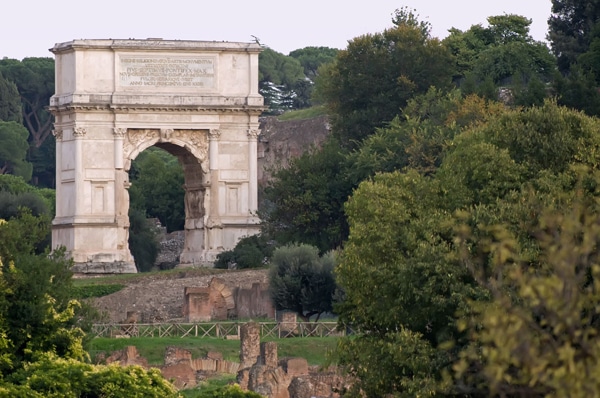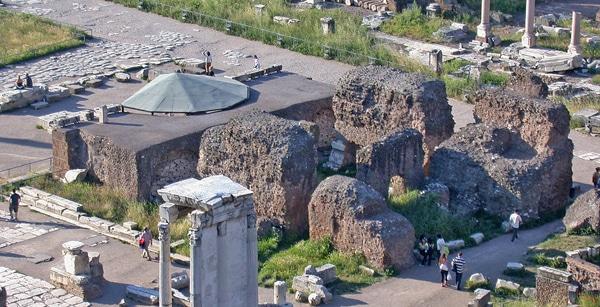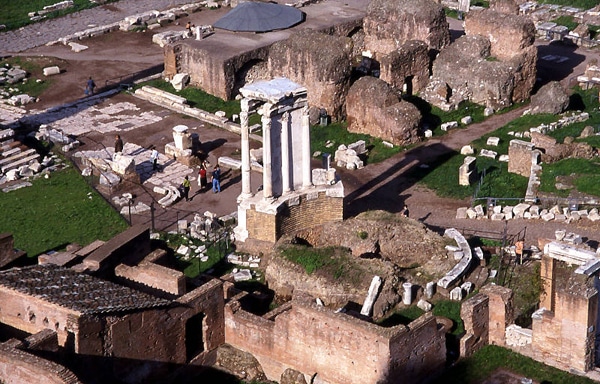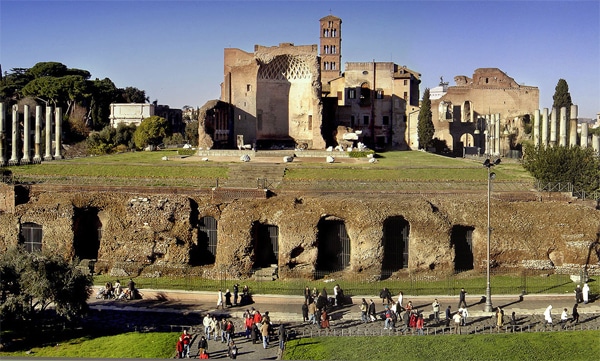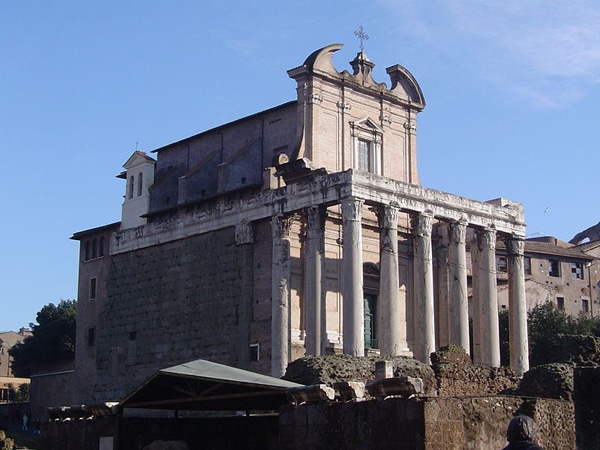In the heart of Rome lies an ancient monument as old as the Eternal City itself – the Roman Forum (Latin: Forum Romanum). The irregular sequence of ancient columns and partially ruined vaults of temples showcase the former glory of the Roman Empire. This site of 500 square meters gathers the architecture, history, and culture of ancient Rome.
Page Contents
History
Even during the Roman state’s peak, a significant tract of undeveloped land remained within the capital’s boundaries. The lowland between six hills in the city center was flooded by numerous springs.
Until the 8th century BCE, this marshy area was used as a cemetery for the city’s inhabitants.
The situation changed during the reign of Tarquinius Priscus (Latin: Tarquinius Priscus). The Roman ruler implemented an extensive drainage system that dried the valley’s soil. Throughout the 7th and 6th centuries BCE,
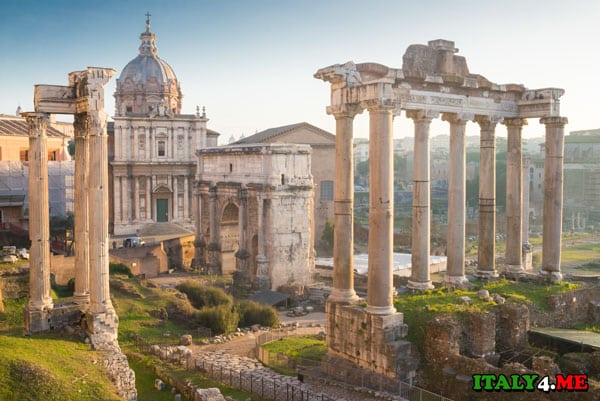
Rome acquired a system of compacted earth roads. The capital’s plain transformed into a convenient area where trade rows and a platform for public speeches emerged. Thus, the social and economic status of the Forum Romanum began to take shape.
Construction
Temple of Venus Cloacina
The first significant structure in the square was the Temple of Venus Cloacina (Venus Cloacina). This sanctuary has not survived to the present day, but ancient legends tell that the temple was used for the purification rituals of Roman warriors and captive Sabine women.
The Black Stone
The Roman Forum also boasts another legendary site – the marble obelisk “The Black Stone” (Lapis Niger). Dated to the 6th century BCE, this monument, according to ancient manuscripts, marked the spot where Romulus, one of the founders of Rome, perished. Excavations beneath the stone’s surface uncovered slabs with ancient writings, tracing the formation of Latin as derived from the Greek language.
Comitium and Rostra
The Forum’s map indicates the original location for public debates – the Comitium (Comitium). The term “comitium” translates from Latin as “assembly”. The description of the comitium is preserved in ancient manuscripts – it was a circular amphitheater with several tiers of tribunes. Built in the 5th century BCE, it was named “Rostra Vetera” (Rostra Vetera). Adorned with ship prows (rostra), the tribune successfully fulfilled its functions up to the beginning of our era.
The City’s Navel
During the regal period, a small temple called the Navel of the City (Umbilicus urbis) was established in the Roman square. The rulers decided to emphasize the significance of the Roman Forum, designating its key role in the life of the capital. The once ceremonial building, adorned with marble, is now reduced to ruins.
Temple of the Dioscuri
From the 5th to the 2nd century BCE, the Roman Empire engaged in various military conflicts, including three significant wars with the Phoenicians, impacting the capital’s appearance. Majestic Rome received funds for beautification. One of the constructions from this period is the Temple of the Dioscuri (Aedes Castoris), honoring Jupiter’s sons – Castor and Pollux. The ancient sanctuary has survived to the present day as the antique columns known as “The Three Sisters”.
Sacred Road
In the 5th century BCE, the rulers of Rome seriously focused on strengthening the city’s roads. The Sacred Road (Via Sacra) was laid as part of the land development works, leading deep into the Roman Forum. Initially, this wide path by the 4th century was adorned with colonnades and paved with tuff.
Temple of Saturn
The map of the Roman Forum marks another majestic building on the southwest – the Temple of Saturn (Templum Saturni). The columns of this ancient Roman sanctuary still reach for the blue sky of the capital. The grand temple was erected to celebrate the Romans’ victory over the Etruscan ruler Tarquin. The landmark had a tumultuous history, turning to ash and resurrecting like a Phoenix. For a prolonged period, the Temple of Saturn served as a treasury and tax service, known as the Aerarium, from the Latin word “aerarium” – “allowance, treasury”.
Temple of Concord and Temple of Vespasian
At the very western edge of the Forum in the 4th century BCE, the Temple of Concord (Tempio della Concordia), the goddess of harmony, was built. The emergence of this temple symbolized reconciliation between the Roman nobility and commoners. Slightly south of the Temple of Concord, one can see the ruins of the Temple of Vespasian. A few surviving columns are all that remains of the sanctuary dedicated to Emperor Vespasian (Templum divi Vespasiani) and his successor Titus.
The Three Ancient Basilicas
During the 2nd century BC, the architecture and significance of the Roman Forum underwent substantial changes. On the grounds of the wealthy Romans, three new temples were constructed. The Basilica Porcia (Latin: Basilica Porcia) emerged, thanks to the efforts of the politician Marcus Porcius Cato (Latin: Marcus Porcius Cato), a renowned law enforcer.
Porcius transformed the basilica into a court of law, where he administered justice over avaricious individuals and resolved financial disputes. The building was destroyed by fire in the 1st century BC.
The Basilica Aemilia (Latin: Basilica Aemilia) also did not survive today. Gray floor tiles and the foundations of ancient columns remain of the once-magnificent building, which served for debates and legal proceedings. The Temple of Dioscuri columns stand at the basilica’s head.
The Basilica Sempronia (Latin: Basilica Sempronia) could have been considered the oldest basilica in Rome, had it not been destroyed by Julius Caesar (Latin: Gaius Iulius Caesar) in the 50s BC.
The great emperor erected the Basilica Julia (Latin: Basilica Iulia) southwest of the Roman Forum. Unlike the Basilica Sempronia, the new construction was impressively sized – 101 by 49 meters. Scholars believe that the basilica had three floors. Civil cases, including property disputes, were adjudicated inside. In the 3rd century AD, the temple was destroyed by a severe fire.
Curia Julia
In the 1st century BC, Julius Caesar moved the Roman Senate meeting place to the Curia Julia (Curia Iulia). The map of the square indicates that the new building was located slightly north of the Comitium. The original architecture of the curia has not been preserved; only the remains of the reconstructed building from the 3rd century AD have survived to this day. In the 7th century, the curia was transformed into a church. Antique floor tiles remind us of the solid history of the building. Inside the church are decorative elements of the Curia Julia – rostra adorned with relief images.
The Tabularium
The ancient Forum includes a partially preserved building – the Tabularium (Tabularium). Constructed in the 1st century BC, it served as a state archive, storing various acts. Evidently, the Tabularium once had a multi-story structure, its stern architecture enlivened by arched vaults. Currently, the foundation and first floor of the building are well-preserved, along with interior decor elements.
The Arch of Titus
The southeastern entrance to the Roman Forum is adorned by the triumphal Arch of Titus (Arco di Tito), erected in the 1st century AD by Emperor Domitian (Latin: Flavius Domitianus) in honor of the deceased ruler Titus. The powerful, white portal from Attica was clad in marble. The arch’s opening is decorated with relief images of the goddess of victory, Victoria, and battle scenes from the Siege of Jerusalem.
The Temple of Caesar
In 27 BC, the Roman Republic transformed into an empire. Its first emperor, Julius Caesar, and his successor, Octavian Augustus, exerted maximum effort to turn the Roman Forum into their state’s cultural, political, and religious center. Imperial victories were commemorated by the triumphal Arch of Augustus, located near the Temple of Caesar (Aedes Divi Iuli).
After his death, the body of Rome’s first emperor was cremated. A temple was subsequently built on the cremation site, where Caesar’s deification took place.
Ancient Roman coins showcase what the temple’s architecture looked like. The building itself has come down to us as imposing ruins.
The Temple of Vesta
The posthumous imperial halls are concealed from visitors’ eyes by an incomplete circle of pristine white columns, which in the past constituted the Temple of Vesta (Aedes Vestae). The patroness of the hearth was honored with a circular temple. Day and night, a flame burned inside the building, its smoke rising to the heavens. Imperial daughters and Vestal priestesses vigilantly tended the fire and performed rituals to appease the goddess.
The Temple of Venus and Rome
In the 2nd century AD, Emperor Hadrian (Latin: Traianus Hadrianus) commissioned the construction of a grand temple dedicated to two patron goddesses of Rome – Venus and Rome (Tempio di Venere e Roma). The architecture of this massive structure was unusual: two cellars (domes) of the sanctuary were built facing each other. The temple was flanked by a series of ancient columns.
This architectural composition connected the Colosseum and the eastern edge of the Roman Forum.
Later, one of the cellars was transformed into the church of Santa Francesca Romana. Thus, it is the best preserved among all the other structures.
The Temple of Antoninus and Faustina (Tempio di Antonino e Faustina)
Antoninus Pius (Latin: Antoninus Pius), in 141 AD, built a beautiful temple dedicated to his prematurely deceased wife, Faustina. After he died in 161 AD, the sanctuary received its current name – the Temple of Antoninus and Faustina. The ancient Roman structures were utilized by Christians in the 11th century to create the church of San Lorenzo in Miranda. This is because modern tourists can admire a Romanesque basilica surrounded by a perimeter colonnade.
The Arch of Septimius Severus
At the dawn of the 3rd century AD, Emperor Septimius Severus (Latin: Septimius Severus) commanded the construction of a triumphal arch (Arco di Settimio Severo) at the northern entrance of the plaza. The commander’s and his sons’ resounding victories were immortalized through a marble arch adorned with solemn decor. The relief carvings on the cladding plates depict the heroic battles of the Romans against the inhabitants of Parthia.
The Basilica of Maxentius and Constantine
The most impressive and grandiose structure of the Roman Forum remains the Basilica of Maxentius and Constantine (Basilica di Massenzio).
The construction began in 308 AD by Emperor Maxentius, who was soon overthrown by Constantine.
Thus, on the square’s eastern side, a substantial three-aisled temple measuring 100 by 65 meters was erected. The remains of the ancient building allow us to imagine the basilica’s architecture. In its prime, the temple was adorned with a colossal statue of Maxentius, later replaced by a sculpture of Constantine. Leaf gold and marble splendidly complemented the stone embodiment of the ruler.
How to Get There, Opening Hours, and Tickets
Important tip: A 12 euro ticket to the Roman Forum also includes visiting the Colosseum and Palatine Hill. So when you’re in Rome, you don’t necessarily have to stand in the two-hour queue at the Colosseum ticket office like all the other unfortunate tourists. Instead, you can walk 100 meters away and buy the same ticket at the Forum’s box office. Our more advanced readers can follow these instructions and book tickets to the Colosseum online in advance.
- Ticket Price: 18 euros, if you are under 17 years old, show your passport and enter for free.
- Address: Entrance from the side of the Palatine Hill Via di S. Gregorio, 30;
- Via Metro to the “Colloseo” station, Line B;
- Via Tram №3 or Buses № 60, 75, 84, 85, 87, 117, 175, 271, 571, 810, 850; № 3, to the “Colloseo” stop;
- Official Website: coopculture.it
- Opening Hours: from 08:30 to 17-18 hours depending on the season.
 Italy for me From Italy with love
Italy for me From Italy with love

